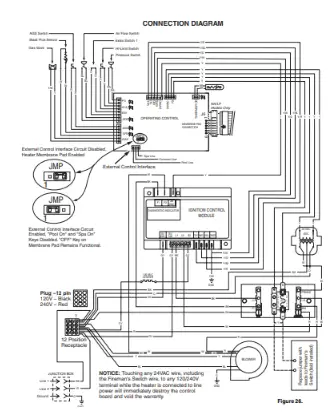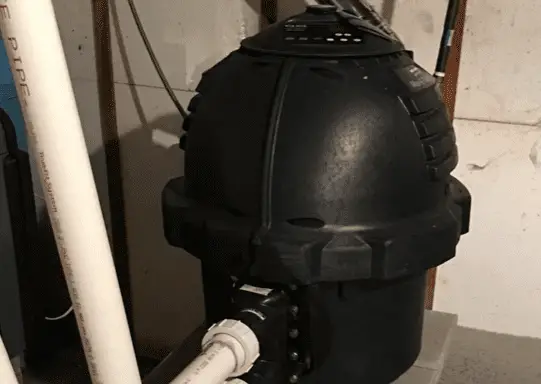There can be many reasons why your Sta Rite pool heater won’t turn on. The possible causes can vary a lot which makes it hard to narrow down what needs fixing. So, you will need to rule out the possible issues patiently.
The common troubles behind a pool heater not starting up include- a bad temperature sensor, incorrect wiring, low voltage supply, and tripped fireman’s switch.
Also, a broken membrane pad, damaged control board, blocked filter, incorrect water pressure, low water flow rate, ignition failure, and tripped safety switches are responsible for your Sta-Rite pool heater not turning on.
Keep reading our Sta-Rite pool heater troubleshooting guide to get your heater running ASAP.
Table Of Contents
- Sta Rite Pool Heater Won’t Turn On [11 Easy Fixes]
- 1. Bad Temperature Sensor
- 2. Incorrect Wiring
- 3. Low Voltage Supply
- 4. Tripped Fireman’s Switch
- 5. Broken Membrane Pad
- 6. Damaged Control Board
- 7. Low Water Flow Rate
- 8. Blocked Filter
- 8. Incorrect Pump Pressure
- 9. Ignition Failure
- 10. Tripped Safety Switches
- FAQs:
- What to do when the heat pump is on but not running?
- How hot should a pool pump motor be?
- Is 90 degrees too hot for a pool?
- How much heat does a pool lose overnight?
- What is the difference between a vertical and horizontal pump?
- Conclusion
Sta Rite Pool Heater Won’t Turn On [11 Easy Fixes]
We will now take a detailed look at the causes behind your pool heater not turning on. In this section, we will also explore the simple solution for each of the problems.
1. Bad Temperature Sensor
When your heater’s temperature sensor isn’t working properly, you will get the wrong water temperature readings.
So, your heater may think that the water temperature already has reached the temperature setting on the thermostat when in reality it hasn’t.
As a result, the thermostat won’t call for heat, and your Sta-Rite pool heater won’t turn on.
Solution:
Make sure the remote thermostat is set at 104°F or lower. If indeed the remote thermostat’s temperature setting is acceptable, or if the heater is not equipped with a remote thermostat, check for adequate water flow.
The table below shows the recommended water flow for various Sta-Rite models.
| Model | Flow Rate |
| 200 | 20 gal/min (76 LPM) |
| 333 | 30 gal/min (114 LPM) |
| 400 | 40 gal/min (151 LPM) |
After that, compare the temperature readout on the heater to the true water temperature. A thermometer will be required.
If the discrepancy is significant, change the intake water temperature sensor.
2. Incorrect Wiring
In case there are any incorrect connections made or damaged wiring, your heater may not start up. It could also be that the wiring is correct but loosely connected.
Solution:
Your heater’s wiring should be inspected. Replace any damaged wires after cross-checking every one of the wiring connections.
Then you need to check that all the connections are tightly secured. You might find the Sta-Rite pool heater wiring diagram below useful.

3. Low Voltage Supply
Your pool heat pump will not turn on if the electrical socket does not provide enough electricity. Your heater may be unable to start due to a lack of sufficient electricity.
Solution:
It’s possible that the voltage in your outlet is lower than required. The problem could be a defective electrical connection if the heat pump used to work perfectly when attached to the same outlet but no longer does. Take the following precautions.
- Ascertain that the heat pump is receiving adequate power (usually 24 volts or 12 volts depending on the model)
- Check the wiring for any breakage or lose connections.
- Examine the wiring terminals for corrosion.
4. Tripped Fireman’s Switch
You will not have a working heater if the Fireman’s Switch or the fuse on your Sta-Rite pool heater has blown.
Solution:
Keep an eye on the glass ignite. The fuse will blow if the string on the inside of the fuse breaks at some point. Replace the old Fireman’s Switch with a new one. Your pool heater should now be operational.
5. Broken Membrane Pad
A broken membrane pad can be why your heater won’t start up.
Solution:
Here’s how you test the membrane pad.
- Check the connection of the ribbon cable between the Membrane Pad and J6 on the Control Board. On the pad, press “POOL” or “SPA” once again. Is the “POOL” or “SPA” LED on?
- If yes, the membrane pad is fine. If not, look at J6 of the Control Board. Jumper pins 6 and 5. After that, if the “SPA” LED lights up, you have a malfunctioning Membrane Pad that needs replacement.
6. Damaged Control Board
Your heater’s control board is comparable to a computer’s motherboard. It is required by the heater. Your heater may be refusing to turn on due to a faulty control board.
Solution:
For assistance, contact the manufacturer of your heater. A replacement control board can be sent to you.
You can change the control board yourself if you have some knowledge of electrical appliances. Otherwise, we advise you to get expert help.
7. Low Water Flow Rate
Due to a lack of water flow, an obstruction in your pool system can prohibit your heater from turning on.
Solution:
Make sure your pool filter is in good working order. Clean out the baskets. Check that the pump is delivering enough water to the system.
8. Blocked Filter
A filthy and clogged pool filter is the most common cause of low water pressure. If your heater won’t turn on, it’s likely that there’s nothing wrong with it other than a filthy filter, which is readily fixed.
Solution:
A sand, DE, or cartridge filter is the type of filter you have. DE and sand filters are the most popular in my experience. Cleansing a cartridge filter is more difficult.
To clean your DE filter, remove the elements from the tubing and open it up. Your filter should typically have four elements.
Wash out as much dirt and debris as you can with your garden hose. Replace any pieces that have become too worn to be reused and reassemble the filter. If you have a sand filter, backwash it according to the guidelines below.
- Turn the water supply off. Ensure that the valves on the suction & return lines are closed. To clear the filter basket, remove the pump’s lid.
- If required, replace the lid. Open the valve on the drain outlet. Turn the knob to the BACKWASH position. The return and suction lines’ valves must be open.
- Start the pump. Rinse for 1–2 minutes, or until the sight glass fluid is clear. Turn off any electric heaters you have. Turn the water supply off.In case you have a sand filter, follow the instructions below to backwash it.
- Start the pump and rinse for 15-30 seconds after sliding the lever to the RINSE position. To stop the pump, set the lever to FILTER. This is the typical working situation.
- After closing the drain outlet valve, start the pump. Turn the heater on.
8. Incorrect Pump Pressure
Changing filter pump pressure can result in wear of the pump, reduce water flow, and malfunction of the heater.
Pressure fluctuations can happen due to air leaks, low water levels, stuck skimmer weirs, or clogged suction pipes. Varying pump pressure can cause your Sta-Rite heater to not start up.
Solution:
Backwashing your pool filter is a good place to start. If cleaning the pool filter does not solve the problem, you must determine which of the factors listed above is to blame.
- To ensure a flawless seal and no air leaks, make sure your pump lid is free of cracks and the O-ring is consistent and damage-free. Also, any damaged or cracked fittings leading into the pump should be replaced.
- Simply add enough water to your pool to reach the right levels if necessary, and your surge or pump pulsing problem should be remedied quickly.
- Examine your weir’s hinges for proper operation and fix any damaged or jammed doors.
- Use a high-pressure attachment or a drain king to clear clogged suction pipes. Connect it to the front of the pool pump to send debris to the skimmer box.
9. Ignition Failure
If your heater’s ignition system is compromised your heater may not start up. An ignition failure can be a result of insufficient pump pressure, a broken flame sensor or pressure sensor, a bad blower, a lack of airflow, and an insufficient gas supply.
Solution:
You need to figure out which element of the ignition system is the culprit. Read this article on pool heater ignition failure to get a more detailed understanding. Call in a professional if you are unsure how to fix the issue.
10. Tripped Safety Switches
The safety switches protect your unit from being damaged. These switches trip whenever they detect a problem with the pool heater and turn off the power.
Safety switches such as the pressure switch, high limit switch, automatic gas shutoff, and airflow switch can trip for a variety of reasons.
Solution:
When any of these safety switches trips, you’ll almost certainly obtain an error code. It’s possible that the Sta-Rite service heater light will turn on.
The error codes signify which of the safety switches is activated. You must determine why the switch tripped and then reset it. After you’ve reset the safety switch, your heater should be able to turn on.
FAQs:
What to do when the heat pump is on but not running?
Ensure all valves are in the proper position to ensure proper water flow if your heat pump is on but not running. Make sure the filters and pump baskets are free of debris as well. Also, keep in mind that the filter pump must be functioning in order for the heat pump to work.
How hot should a pool pump motor be?
Pump motor bearings can withstand temperatures of up to 200 degrees, thus 115-200 degrees is a safe “hot” temperature for a heat pump. A pool pump motor uses level ‘B’ insulation, which permits the internal temperature of the motor to exceed 256 degrees.
Is 90 degrees too hot for a pool?
No, it’s fine. While pools should never exceed 95 degrees, for adult swimmers or toddlers learning to swim, any temperature between 90 and 92 degrees gives a comfortable yet therapeutically heated environment.
How much heat does a pool lose overnight?
Overnight, an unprotected pool can lose up to 5 degrees F; a decent cover can reduce that loss by half. The pool cover, when used at night or whenever your pool is not in use, can help you save money on fuel by reducing heat loss, regardless of the sort of heating you use.
What is the difference between a vertical and horizontal pump?
The main distinction is the shaft’s orientation. The shaft of a horizontal centrifugal pump is usually mounted horizontally, either between the bearings or overhung. A vertical centrifugal pump, on the other hand, has a vertical shaft.
Conclusion
Hopefully, our guide could help you to turn your heater back on. There are so many possible things that can be wrong with the heater when it won’t turn on that it becomes difficult to diagnose the issue.
So, if you are confused and haven’t got much understanding of pool heaters, calling in a professional is best.

